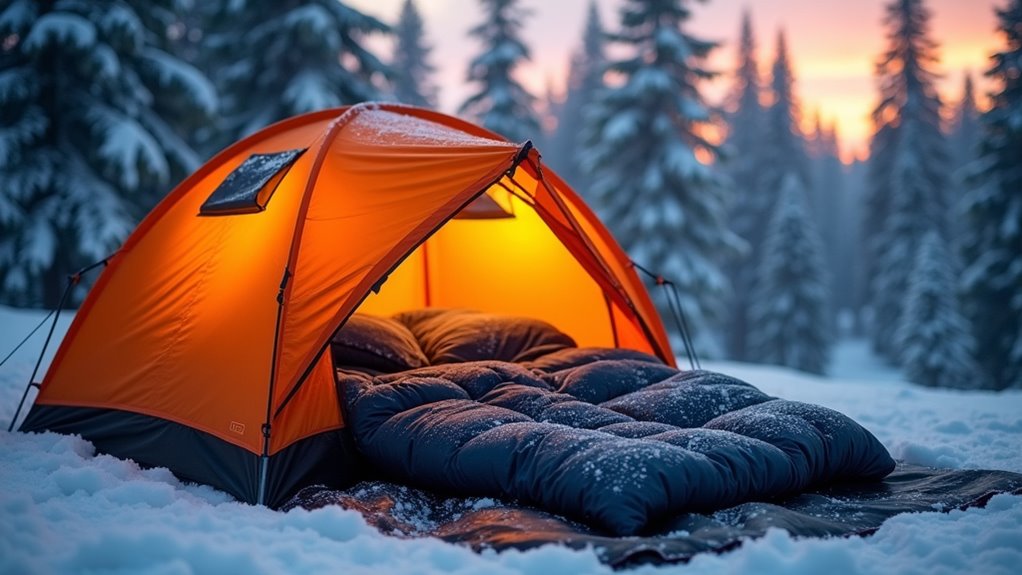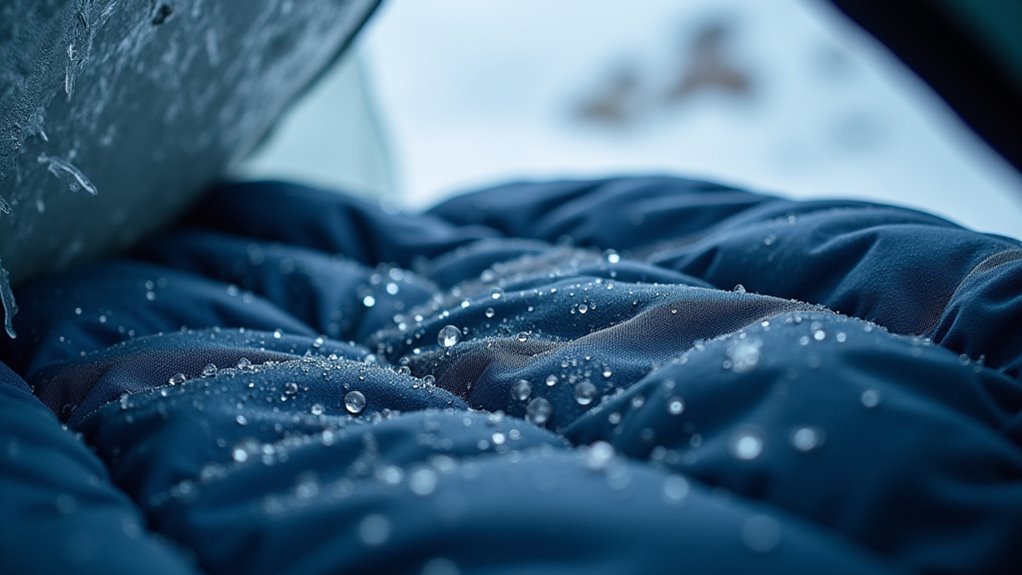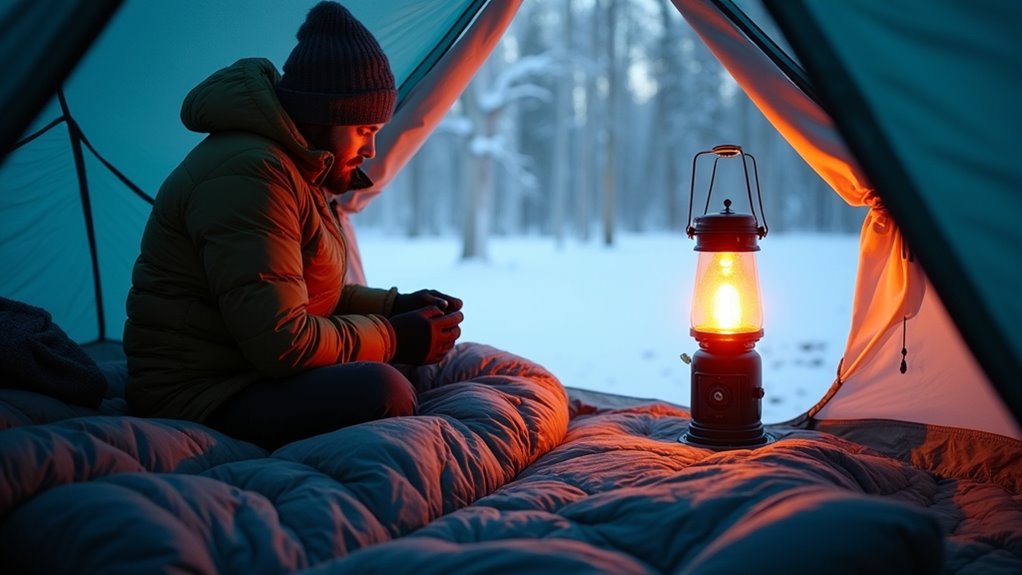Physical Address
304 North Cardinal St.
Dorchester Center, MA 02124
Physical Address
304 North Cardinal St.
Dorchester Center, MA 02124

Keep warm all night during winter camping with these 8 expert techniques that go far beyond what your sleeping bag can do alone.
Most winter campers don’t realize that your body generates less heat while sleeping, making you vulnerable to hypothermia even in a bag rated for the current temperature. You’ll need to go beyond basic gear selection and employ strategic techniques that address heat loss, moisture management, and thermal efficiency. These eight proven methods will transform your winter camping experience from a survival ordeal into the restful night you’re craving, but they require precise execution to work effectively.

How do you determine which sleeping bag will actually keep you warm when temperatures plummet below freezing? You’ll need to understand temperature ratings and choose wisely. Look for bags rated at least 10-15 degrees lower than the coldest temperature you expect to encounter. Don’t rely solely on comfort ratings—they’re often optimistic. Instead, focus on survival ratings for a realistic baseline.
Down insulation offers superior warmth-to-weight ratio but loses effectiveness when wet. Synthetic fill performs better in damp conditions but weighs more. Check the bag’s shape too—mummy bags retain heat better than rectangular ones.
Consider your sleeping style: cold sleepers need lower-rated bags, while warm sleepers can get away with higher ratings. Always pair your bag with a quality sleeping pad for ground insulation. Remember that selecting the right bags goes beyond just temperature ratings and includes considering your specific camping conditions and personal comfort needs.
Even with the warmest sleeping bag, you’ll lose significant body heat if cold seeps up from the frozen ground beneath you. Ground insulation is critical for winter camping comfort and safety. Your body weight compresses your sleeping bag’s insulation underneath you, creating cold spots that drain warmth throughout the night.
Your sleeping bag’s insulation compresses beneath you, creating dangerous cold spots that steal precious body heat all night long.
Here’s what you need for proper ground insulation:
Invest in quality ground insulation—it’s often more important than your sleeping bag rating. While focusing on warmth, don’t forget that proper ground barriers also help prevent insect bites that can disrupt your sleep even in winter conditions.

While ground insulation protects you from below, strategic clothing layers create a thermal barrier that traps warm air around your body throughout the night. Start with a moisture-wicking base layer made from merino wool or synthetic materials—never cotton, which retains moisture and loses insulation properties when wet.
Add an insulating middle layer like fleece or down that creates loft for heat retention. Your outer layer should be breathable yet wind-resistant to prevent heat loss while allowing moisture to escape.
Don’t overdress before getting into your sleeping bag. You’ll generate heat quickly once you’re inside, and excessive clothing can compress your bag’s insulation, reducing its effectiveness.
Keep a dry set of sleeping clothes separate from your daytime gear to ensure you’re not bringing moisture into your sleeping system.
These adventurous camping tricks will help maintain your core body temperature even in the most challenging winter conditions.
Since cold air naturally settles in low-lying areas, you’ll want to pitch your tent on elevated ground whenever possible to avoid these thermal sinks. Your shelter placement and setup directly impact how much heat you’ll retain throughout the night.
Follow these essential shelter strategies:
These adjustments create a warmer microenvironment that’ll keep you comfortable all night long. While winter camping requires careful preparation, implementing these shelter techniques alongside family camping activities can help create memorable outdoor experiences even in colder weather.

Beyond securing your shelter from external cold, you’ll face another formidable challenge that can ruin your winter camping experience: moisture buildup inside your tent and sleeping system. Your breath creates significant condensation that’ll freeze on tent walls and drip onto your gear.
Combat this by cracking your tent’s ventilation zippers slightly—even in freezing temperatures. Keep wet clothes and boots outside your sleeping bag, storing them in stuff sacks at your feet instead. Wipe down interior tent walls before bed using a small towel.
Consider sleeping with a lightweight balaclava to redirect breath away from your bag’s interior. If condensation does accumulate, brush ice crystals off fabric before they melt and soak through.
While managing moisture, remember that winter camping also increases your exposure to ticks in certain regions, so perform regular tick checks on your body and gear when breaking camp.
Your body generates heat through digestion and metabolism, making strategic late-evening snacking a powerful tool for staying warm throughout the night.
Complex carbohydrates and healthy fats provide sustained energy release, keeping your internal furnace running while you sleep.
Choose foods that’ll fuel your body’s natural heating system:
When planning your winter camping menu, consider incorporating these same warming foods throughout your entire trip for consistent energy and heat production. These winter camping foods work just as effectively during daytime meals and snacks to maintain your core body temperature in cold conditions.
Avoid heavy meals that’ll disrupt sleep, but don’t go to bed hungry either.
A light snack 30-60 minutes before sleeping optimizes your body’s heat production.

While your body’s natural heat production helps, you’ll likely need additional warmth sources during frigid winter nights—but using them incorrectly can lead to carbon monoxide poisoning, burns, or tent fires.
Always use battery-powered heaters designed for enclosed spaces, never propane or gas heaters inside your tent.
Place hot water bottles or heated stones in wool socks before putting them in your sleeping bag—direct skin contact causes burns.
Hand and foot warmers work great when activated outside your bag first.
Create a buffer zone between you and heat sources.
Keep tent ventilation partially open even when using safe heaters to prevent condensation buildup.
Test all heating devices at home before your trip, and always have backup power sources for battery-operated equipment.
Consider bringing a portable espresso maker to enjoy a quick warming drink that can help raise your core temperature before settling into your sleeping bag for the night.
Even with proper insulation and heating equipment, how you arrange your body and gear inside your sleeping system determines whether you’ll stay warm or shiver through the night. Your positioning strategy directly impacts heat retention and circulation.
Optimize your thermal efficiency with these positioning techniques:
Smart positioning inside your sleeping system can mean the difference between restful warmth and a miserable, shivering night outdoors.
Don’t forget to change out of damp clothes before sleeping, as moisture destroys insulation properties and accelerates heat loss throughout the night. Plus, ensure your tent is properly sealed and bug-free before settling in, as having to deal with insects during cold nights can disrupt your sleep and force you to break your thermal barrier.
You’ve now built your fortress against winter’s bite, layer by layer. Like a hibernating bear, you’ll cocoon yourself in warmth while the cold prowls outside your shelter. Your sleeping bag becomes your shield, your layers your armor, and your preparation your sword against the night. Don’t let winter’s fangs pierce your comfort—embrace these techniques and you’ll transform frozen darkness into restorative sanctuary. Sleep well, knowing you’ve conquered winter’s challenge.